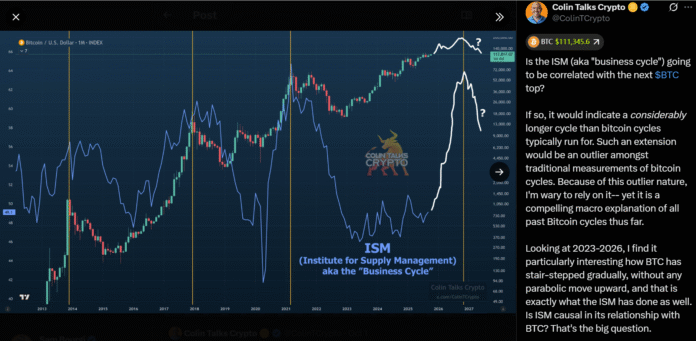Uncovering the Correlation Between ISM Manufacturing PMI and Bitcoin’s Market Cycles
The Institute for Supply Management’s (ISM) Manufacturing Purchasing Managers’ Index (PMI) has historically demonstrated a notable alignment with major peaks in Bitcoin’s market cycles. This pattern, if repeated, could imply a longer-than-usual cycle for the cryptocurrency. The correlation between the ISM PMI and Bitcoin’s (BTC) price was first popularized by Real Vision’s Raoul Pal and has since gained traction among macro-focused crypto analysts.
Analyst Colin Talks Crypto noted, “All 3 past Bitcoin cycle tops have broadly aligned with this monthly, oscillating index,” referencing the recurring overlap between Bitcoin’s market highs and the PMI’s cyclical peaks. If this relationship holds, Colin added, “it would indicate a considerably longer cycle than bitcoin cycles typically run for.”
Source: Colin Talks Crypto
Understanding the ISM Manufacturing PMI and Its Impact on Bitcoin
The ISM Manufacturing PMI, which measures US industrial activity, has remained below the neutral 50 mark for seven consecutive months, signaling contraction. A sustained move above 50 would suggest renewed economic expansion, historically associated with stronger Bitcoin price performance. Earlier this year, the PMI briefly climbed above 50 before slipping back into contraction territory, underscoring continued weakness in the manufacturing economy.
ISM Manufacturing PMI. Source: TradingEconomics
US Manufacturing Struggles and Its Potential Impact on Bitcoin’s Cycle
The manufacturing PMI signaled a strong rebound in business sentiment at the start of the year, partly attributed to optimism surrounding the incoming Trump administration and expectations of business-friendly policy. However, the continued drag from high tariffs, uncertain trade policy, and soft global demand has weighed on the sector, potentially extending the business cycle rather than accelerating it.
ISM’s latest report showed a modest uptick in September, with prices rising while exports and imports contracted, suggesting uneven conditions across manufacturing subsectors. Despite the weakness, ISM noted that manufacturing’s shrinking share of US economic output means a contraction in the PMI does not necessarily signal a recession. ISM has previously observed that a sustained reading above 42.3 generally corresponds with growth in the broader economy.
One purchasing manager from the transportation equipment industry told ISM in September that “business continues to be severely depressed,” citing shrinking profits and “extreme taxes” in the form of tariffs that have raised costs across the supply chain. “We have increased price pressures both to our inputs and customer outputs as companies are starting to pass on tariffs via surcharges, raising prices up to 20 percent,” they added.
Read more about the potential correlation between the ISM Manufacturing PMI and Bitcoin’s market cycles at https://cointelegraph.com/news/ism-manufacturing-pmi-bitcoin-cycle-extended?utm_source=rss_feed&utm_medium=rss_tag_bitcoin&utm_campaign=rss_partner_inbound

